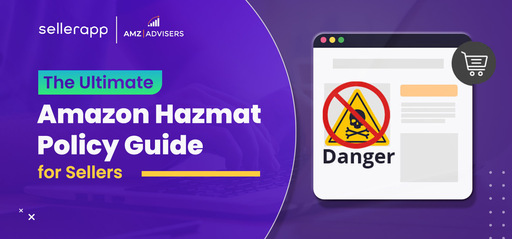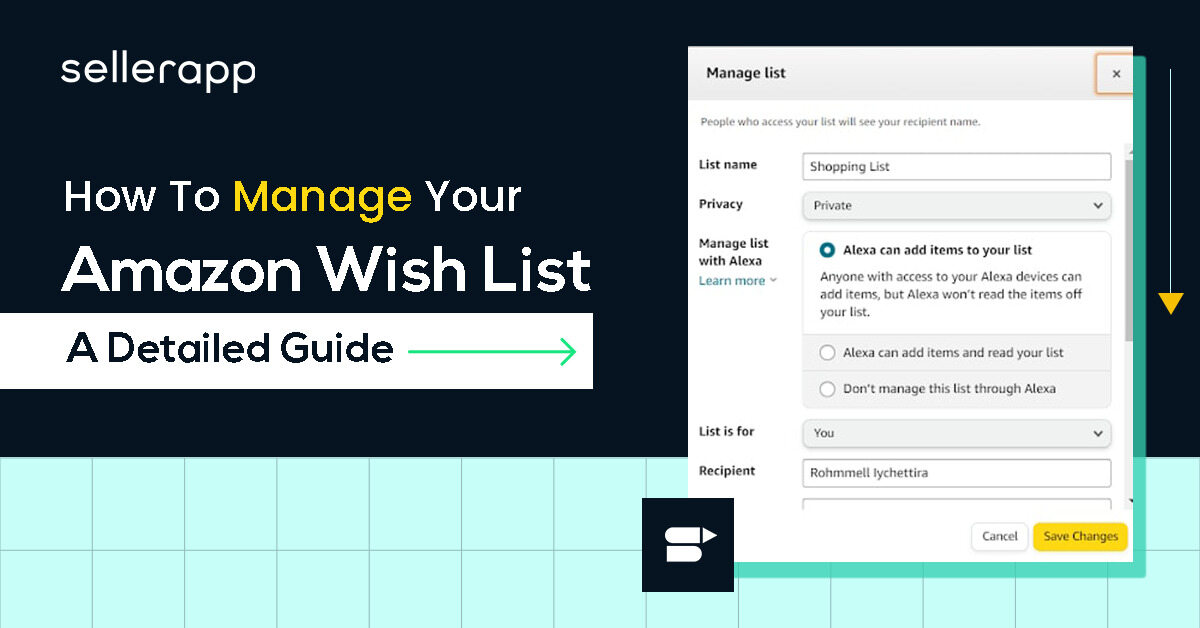The Ultimate Amazon Hazmat Policy Guide for Sellers

Most products are safe to use by customers, and safe to sell by brands on Amazon. Users want them, and sellers are ready to provide them. But some articles fall under a different category. These are dangerous goods or hazardous materials (hazmat for short).
Hazmat goods contain elements that make them high-risk products, to a point. Think of electronic devices, auto parts, and oils, or beauty products.
Amazon FBA sellers must know which products pose latent safety or health risks. That way, brands can ensure safe storage, handling, transport, and usage of such items.
Luckily, the marketplace features a set of guidelines to manage and sell hazmat goods. Today, we’ll review Amazon’s hazmat policies to conserve a harm-free marketplace.
Quick Guide
- What Counts as Hazardous Materials?
- Dangerous Goods Review Process
- FBA Dangerous Goods Program
- FBA Storage of Hazmat Products
- Seller Compliance and Responsibility
- How to Submit an SDS or Exemption Sheet
- Final Thoughts
What Counts as Hazardous Materials?
Dangerous products go beyond explosives, weapons, and narcotic substances. Amazon’s hazmat goods are made with toxic or flammable parts. For example:
- Lithium Battery-operated products. Laptops, cameras, smartphones, tablets, or chargers.
- Items with magnetized materials. Speakers and headphones, light meters, and some kid’s toys.
- Products with non-harmful chemicals. Glue and adhesives, spray deodorants, hairspray and hair dyes, or bug-control substances.
Amazon allows FBA merchants to sell the following product classes in limited amounts:
- Flammable solids, liquids and gases
- Non-flammable and non-toxic gases
- Oxidizers and organic peroxides
- Toxic and corrosive substances
- Miscellaneous dangerous substances, such as lithium batteries and magnetized materials
Now, the following classes are prohibited for FBA sales:
- Explosive substances and toxic gases
- Substances dangerous when wet, or liable to spontaneous combustion
- Infectious substances and radioactive materials
Products that contain these materials could prove harmful when stored or used improperly. That’s why it’s so important for sellers to identify hazmat products, and to sell them safely on Amazon.
How to identify hazmat products
To detect hazmat products, look for ASIN classifications in Seller Central. This will help you detect any dangerous goods among your listings.
Another method is to check the Safety Data Sheet (SDS). Product manufacturers provide this to sellers. The SDS includes the hazard classification of each item.
Here’s a partial list of dangerous goods that may be regulated by Amazon. You can check a more detailed list here.
| Category | Items |
|---|---|
| Apparel | Stain removers Hat stiffeners Apparel with rechargeable batteries |
| Baby | Antibacterial items looming and skincare products |
| Books | Song books E-book devices Magazines with beauty samples |
| Food and beverages | Aromatic and essential oils, Foods in aerosol or pressurized containers Spirits High-alcohol goods |
| Health and household | Cleaners and cleansers Dishwashing or laundry powders and liquids |
| Home improvement | Insect and pest control drills |
| Office | Toners and cartridge equipment cleansers Highlighters, markers, pens, and refills |
| Pet products | Ear and eye care Pest control tch remedies Deodorizers |
| Shoes and bags | Light-up shoes sole and shoe stain remover Shoe polish |
| Video games | Controllers Headsets Gamepads |
Dangerous Goods Review Process
Amazon has a Dangerous Goods team ready to review each ASIN converted to Fulfillment by Amazon (FBA). The team’s goal is to make sure hazmat items meet Amazon’s safety standards.
The team works with catalog intel provided by the sellers. So, you must provide accurate and complete listing data to Amazon. This includes the following:
- Product title
- Detailed description
- Bullet points
- Pictures or images
Changes in catalog information may need a second review. In some cases, Amazon may reclassify the product. Also, note that battery-powered items and products without harmful chemicals require a Safety Data Sheet.
From here, Amazon reviews the data and classifies the product. Provided all information is complete, the process will take 2 business days. Then, sellers can use FBA to store and ship their products.
Now, some items could flag as possible dangerous goods when already stocked in the warehouse.
In such cases, Amazon grants 14 business days to meet the product safety compliance requisites. Otherwise, you could risk delayed shipments, canceled deliveries, and stock disposal.
Besides, any incorrect or incomplete data may result in sales blockages. The worst-case scenario is that merchants could lose their selling privileges on Amazon.
FBA Dangerous Goods Program
Amazon features an FBA Dangerous Goods Program. It’s designed for brands that sell FBA-eligible items classified as hazmat products.
The US program has a current waitlist for interested sellers. To join the waitlist, you must do the following:
- Log in to Seller Central.
- Go to Manage Dangerous Goods Classification.
- Choose the FBA Dangerous Goods program option.
- Click on Apply to the FBA Dangerous Goods program.
Some sellers can be added to the waitlist automatically. This will happen if stored products get reclassified as dangerous goods.
The marketplace will notify merchants when they can take part in the program. Once enrolled, Amazon will transfer your items to a warehouse qualified to handle hazmat goods.
FBA Dangerous Good sellers can ship extra products to the warehouse.
They must only follow the next guidelines:
- Ship FBA eligible products.
- Products must be in new condition.
- Pack limited quantities, as stated by the Title 49 of the Electronic Code of Federal Regulations
That said, certain hazmat goods are not eligible for FBA storage and shipping. However, you can still sell them on Amazon, provided you manage fulfillment and delivery.
Note: Dangerous Goods items are Prime eligible. However, some do not qualify for 2-day shipping. This is due to transport regulations since some products are only safe for ground delivery.
FBA Storage of Hazmat Products
As we mentioned above, Hazmat products are stored in qualified fulfillment centers. These warehouses have spaces designed to manage and store dangerous goods.
There are two categories for FBA hazmat goods: aerosol and flammable. Amazon will only store such items in limited quantities to protect employees.
Sellers can check their hazmat product storage limits on Seller Central. Check it in the storage monitor section. You can access it through Shipping Queue and Inventory Performance.
Of course, Amazon has monthly FBA fees to store dangerous goods. To calculate these fees, consider the type of hazmat item, and the volume it’ll take in the warehouses.
Note: Hazmat storage limit is not based on the Inventory Performance Index, but marketplace performance.
FBA Onsite Dangerous Goods
Think of FBA Onsite as a combination of FBA and Seller-Fulfilled Prime (SFP). Amazon optimizes a seller’s warehouse to improve management and fulfillment.
Brands can use Amazon’s proprietary warehouse software to manage their storage. Plus, Amazon selects a registered carrier to ship your goods and overseas deliveries.
It’s a great program to keep a close eye on product quality, packaging, and shipment.
But FBA Onsite does have one setback. The program is not accepting requests to handle dangerous goods, for the moment.
So, if an item is classified as a dangerous good, it will not appear for sale on Amazon. That said, Amazon also has a waiting list for FBA Onsite sellers interested in offering hazmat items.
Here’s how to do it:
- Contact Onsite Seller Support.
- List 5 hazmat ASINs (at least) you’d want to sell.
- Wait for the verdict.
The marketplace will review your ability to handle hazmat items. This goes from training to product compliance with Amazon’s dangerous goods policies.
Seller Compliance and Responsibility
Hazmat goods sent to Amazon must follow the proper standards and regulations. Dangerous products are subject to the following regulations in the US:
- US DOT Pipeline and Hazardous Materials Safety Administration (PHMSA)
- Federal Aviation Administration (FAA)
- Hazardous Materials Regulations (HMR)
- Globally Harmonized System (GHS) of Classification and Labeling of Chemicals
All dangerous goods should meet the applicable regulations. You must also provide complete product data, and an up-to-date SDS or exemption sheet.
Related post: How to Diversify your business with Amazon Global.
How to Submit an SDS or Exemption Sheet
It’s recommended that you submit a valid SDS from the start. This will speed the hazmat review process.
As we said, safety data sheets state if a product contains hazmat components. For example, battery-powered items or chemical-based products.
Now, if you can’t get an SDS, but the item does not contain harmful chemicals, you can upload an exemption sheet. Here’s how to do so:
- Download the sheet template from the Manage dangerous goods classification site.
- Fill in all relevant fields, such as ASIN and warning label acknowledgments.
- Go back to Manage dangerous goods classification.
- Select the ASIN, marketplace and file language.
- Choose the exception sheet (it must be less than 20 MB).
- Click on “Upload file.”
- Repeat the process to submit more sheets.
You can also upload exemption sheets for battery-operated products. The Dangerous Goods team will take 4 business days to review the documents.
Sources: Seller Central and eco engine
Final Thoughts
Unsafe practices translate to accidents and losses. Always check its components to see if it includes hazmat materials.
Sellers must know how to detect any hazmat item on their listings. And then, strive to make product handling as safe as possible.
Think of it as a long-term benefit. Your colleagues will store, handle, and ship items safely. And finally, customers can enjoy a secure product experience.
That’s the goal of Amazon’s hazmat policies. So, follow these safety measures at all times. You’ll manage to protect your business and the marketplace.
Additional Read:
Amazon Temporarily Prioritizes Products Coming Into FBA Centers










Ricky
November 26, 2021How is the storage handled for amazon hazmat products?
Lisa
November 26, 2021Enjoyed reading the content. Thank you for sharing.